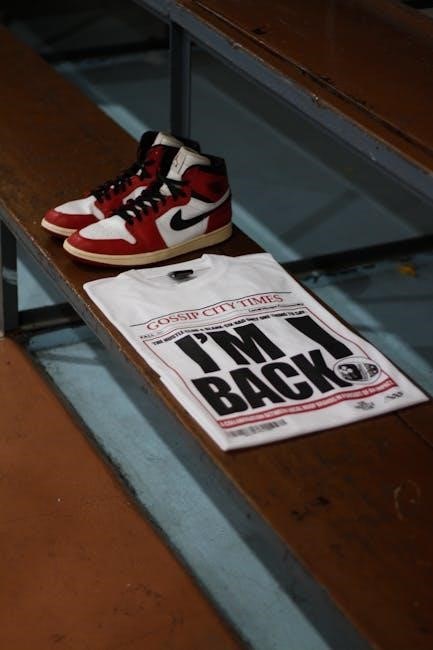
Vintage Nike tags are a gateway to understanding the authenticity, age, and value of classic apparel, offering insights into design evolution and brand history over decades.
What Are Vintage Nike Tags?
Vintage Nike tags are labels sewn into classic Nike apparel, providing details like size, material, and manufacturing dates. These tags help identify the era, authenticity, and value of vintage items, often featuring iconic designs and color codes. They serve as a key resource for collectors and enthusiasts to trace the history and evolution of Nike’s branding and apparel design over the years;
Why Collectors Love Vintage Nike Apparel
Collectors adore vintage Nike apparel for its nostalgic appeal, unique designs, and historical significance. These items often represent iconic moments in sports and culture, offering a tangible connection to the past. The rarity and quality of vintage pieces make them highly sought after, while their potential to appreciate in value adds an investment angle. Additionally, the challenge of discovering rare items and the satisfaction of owning a piece of fashion history drive collectors’ passion for vintage Nike;
The Importance of Tags in Dating Vintage Nike Items
Tags are crucial for accurately dating vintage Nike items, as they often contain specific details like manufacturing dates, color codes, and logos that reflect the era; These elements act as historical markers, helping collectors determine the item’s age and authenticity. Over time, Nike’s tag designs and content have evolved, making them invaluable for pinpointing the exact production period and verifying the item’s legitimacy in the market.

How to Identify Vintage Nike Tags
Examine design elements, color codes, and logos to identify vintage Nike tags, ensuring accuracy by cross-referencing with historical data and evolutionary changes over time.
Understanding the Tag Layout and Design
The layout of vintage Nike tags often features the iconic Swoosh logo prominently, with text arranged in a specific pattern. Early tags typically included basic information like size, material, and care instructions, while later designs incorporated more detailed graphics and color-coded systems. The arrangement of these elements, along with the quality of stitching and materials, provides crucial clues for dating and authenticating vintage Nike apparel. Over time, the design evolved to reflect branding updates and production techniques.
Key Features to Look for in Vintage Tags
Examine the material, stitching quality, and Swoosh logo details. Vintage tags often feature unique serial numbers, color codes, and specific wording like “Made in USA.” Early tags may lack modern branding elements, while later ones incorporate more intricate designs. Pay attention to the tag’s edge stitching, as frayed or uneven edges can indicate authenticity. The presence of specific codes or logos can also help date the item and verify its legitimacy.
How to Spot Rare or Limited Edition Tags
Rare or limited edition tags often feature unique identifiers such as specific color codes, serial numbers, or collaboration logos. Look for tags with “Limited Edition” or “Special Release” text. Unique designs, like commemorative logos or event-specific branding, can also indicate rarity. Check for consistency in the tag’s design with the item’s era. Verify authenticity by cross-referencing with known collections or official resources to ensure the tag’s legitimacy and value.

Materials and Stitching Quality
Vintage Nike tags often feature durable materials like cotton or polyester, with meticulous stitching that reflects the era’s craftsmanship. The quality of stitching and fabric can help determine authenticity and age, as early tags typically exhibit tighter, more consistent stitching patterns compared to later designs.
Common Materials Used in Vintage Nike Tags
Vintage Nike tags were typically made from durable materials like cotton, polyester, or satin. Early tags often featured cotton, which was soft yet resilient, while later designs incorporated polyester for increased longevity. Satin tags were commonly used in the 80s and 90s, offering a smooth, glossy finish. These materials not only ensured the tags lasted but also contributed to the collectibility and authenticity of vintage Nike apparel, making them highly sought after by enthusiasts.
Stitching Patterns in Early Nike Tags
Early Nike tags often featured simple, clean stitching patterns that reflected the manufacturing techniques of their time. Tags from the 1970s and early 1980s typically had single-stitch outlines, while later designs incorporated double-stitching for added durability. Loose, slightly uneven stitching on vintage tags can be a sign of authenticity, as modern counterfeit tags often have tighter, more uniform stitching. These subtle details help collectors distinguish genuine vintage items from reproductions.
Differences in Material Quality Over the Years
Vintage Nike tags reflect changes in material quality as manufacturing techniques evolved. Early tags often featured softer, more prone-to-fraying materials, while later tags used sturdier, synthetic blends. The 1970s and 1980s saw tags with a more natural, cotton-like feel, while the 1990s and 2000s introduced smoother, more durable materials. These shifts in fabric quality help collectors identify the era of their item and understand the advancements in Nike’s production processes over time.
Color Codes and Their Significance
Color codes on vintage Nike tags provide valuable insights into the item’s era, with specific combinations indicating production periods and design trends over the decades.
Nike Color Codes Through the Decades
Nike’s color codes have evolved significantly over the years, reflecting shifting design trends and manufacturing periods. For instance, codes like “001-Mist Grey” and “002-Soft Grey” emerged in the early 2000s, while vibrant hues dominated the 90s. These codes not only identify specific colorways but also serve as markers for dating items, helping collectors pinpoint the era of their vintage finds and understand the brand’s aesthetic shifts over time.
How Color Codes Can Help Date Your Item
Color codes on vintage Nike tags provide crucial clues for dating apparel. Specific codes, like “001-Mist Grey” and “002-Soft Grey,” were used during particular periods, such as the early 2000s. By cross-referencing these codes with manufacturing eras, collectors can determine an item’s age. This method, combined with tag design and material quality, offers a reliable way to authenticate and date vintage Nike pieces, helping enthusiasts pinpoint their item’s origin and historical significance.
Popular Color Combinations in Vintage Nike Apparel
Vintage Nike apparel often features iconic color combinations that reflect their era. Classic red and white, blue and white, and black with neon accents were staples in the 80s and 90s. These vibrant pairings not only represented the brand’s sporty vibe but also became instantly recognizable. Collectors prize these timeless color schemes, as they embody the nostalgic appeal of vintage Nike designs and their enduring influence on modern fashion.

Nike Swoosh Logo Evolution
The Nike Swoosh, designed by Carolyn Davidson in 1971 for just $35, has evolved minimally, maintaining its simplicity while becoming one of the world’s most recognizable logos.
Early Designs of the Nike Swoosh
The Nike Swoosh was created in 1971 by Carolyn Davidson for a mere $35. Its simple, fluid design represented movement and speed, quickly becoming iconic. Early versions often featured the word “Nike” alongside the logo, with minimalistic detailing that emphasized clarity. These early designs laid the foundation for the brand’s identity, blending functionality with aesthetic appeal that remains timeless in vintage apparel.
Logo Changes and Their Impact on Tags
The Nike Swoosh, introduced in 1971, underwent subtle changes over the years, influencing tag designs. Early tags featured the Swoosh alongside the Nike text, while later versions streamlined the logo, often removing the text for a cleaner look. These changes not only reflected branding evolution but also helped collectors date items more accurately, as specific logo styles became synonymous with particular eras in Nike’s history.
Modern Variations of the Swoosh on Vintage Tags
Modern variations of the Swoosh on vintage tags often feature simplified or stylized designs, blending heritage with contemporary aesthetics. These adaptations maintain the iconic symbol’s recognizability while appealing to modern tastes. Collectors prize tags with unique Swoosh renditions, as they indicate limited editions or special releases. Such variations enhance the tag’s collectibility and historical significance, offering a fresh perspective on Nike’s timeless logo.
Authenticity: Real vs. Fake Tags
Authentic vintage Nike tags feature consistent fonts, correct color codes, and precise stitching, while fakes often have misaligned elements or inferior materials, affecting their overall presentation.
Spotting Fake Vintage Nike Tags
Spotting fake vintage Nike tags requires attention to detail. Look for misaligned text, incorrect color codes, or poor stitching. Fake tags often lack the precision found in genuine ones, with inconsistent fonts or blurry printing. Additionally, the material quality may feel off, such as thinner or cheaper fabric. Compare the tag to authenticated examples to identify discrepancies, as genuine tags maintain consistent design and material standards across production years.
Authenticity Verification Tips
Verify authenticity by examining the tag’s details, such as color codes, stitching quality, and font accuracy. Compare the tag to authenticated examples online or in collector communities. Check for correct terminology and era-specific designs. Ensure the tag matches the item’s production period and material quality. Consult experts or trusted forums for confirmation. A genuine tag will align seamlessly with the item’s age and style, while fakes often reveal inconsistencies upon closer inspection.
Common Mistakes in Identifying Genuine Tags
Overlooking small details, such as mismatched fonts or incorrect color codes, can lead to misidentification. Assuming all tags from a specific era are identical ignores variations in design and material. Relying solely on visual inspection without verifying historical accuracy is also a common error. Additionally, failing to consult expert resources or authentic examples can result in incorrect conclusions about a tag’s legitimacy and era. Attention to detail and thorough research are essential.

History of Nike Branding and Tag Design
Nike’s branding and tag design trace back to its founding in 1964, evolving from humble roots to iconic status, with the Swoosh debuting in 1971 and designs refining over decades.
Early Years: The Birth of Nike Branding
Nike’s branding began in 1964 as Blue Ribbon Sports, transitioning to Nike in 1971, inspired by the Greek goddess of victory. The iconic Swoosh logo, designed by Carolyn Davidson for $35, debuted in 1971, symbolizing motion and speed. Early tags were simple, reflecting the company’s humble roots, with minimal branding that emphasized functionality over style, laying the foundation for the global brand we know today.
Evolution of Tag Design in the 80s and 90s
The 1980s and 1990s saw significant advancements in Nike tag design, with the introduction of bold graphics, vibrant colors, and detailed care instructions. This period also marked the rise of iconic campaigns like “Just Do It,” influencing tag aesthetics. The 90s brought standardized branding, including the Nike swoosh and manufacturing details, making tags more recognizable. These designs laid the groundwork for modern tags while maintaining a nostalgic charm for collectors.
Modern Tag Design and Its Roots
Modern Nike tags reflect a blend of legacy and innovation, incorporating timeless elements like the swoosh logo while embracing sleek, minimalist designs. Today’s tags often feature bold typography, simplified care instructions, and a focus on sustainability. Drawing inspiration from their retro counterparts, contemporary tags balance nostalgia with modern aesthetics, ensuring a cohesive brand identity that appeals to both vintage collectors and new generations of sneaker enthusiasts.

Sizing and Fit Information
Vintage Nike sizing often differs from modern standards, with tags providing clues about era-specific fits and measurements, helping collectors accurately date and authenticate their finds.
Understanding Vintage Sizing Charts
Vintage Nike sizing charts differ significantly from modern standards, often reflecting era-specific fits and measurements. Tags from the 80s and 90s typically indicate smaller sizes compared to today’s apparel. Understanding these charts helps collectors date items accurately, as sizing systems evolved alongside manufacturing practices. Vintage tags may also show variations in material quality and fit, offering insights into how Nike adapted its designs over the years to meet consumer demands.
How Sizing Has Changed Over the Years
Nike sizing has evolved significantly over decades, reflecting changes in fashion, manufacturing, and consumer preferences. Vintage items often feature smaller, more tailored fits compared to modern standards. In the 80s and 90s, sizes were less standardized, while today’s apparel tends to be roomier. Understanding these shifts is crucial for collectors to accurately assess the era and fit of vintage Nike apparel, ensuring a proper match when purchasing or wearing classic pieces.
Fit Differences in Vintage Nike Apparel
Vintage Nike apparel often features distinct fit characteristics, such as boxier cuts in 80s and 90s designs, while earlier decades favored narrower, more tailored fits. Sleeves and torsos may appear shorter by modern standards, and armholes tend to be higher. These differences reflect era-specific fashion trends and manufacturing practices, making vintage pieces unique compared to contemporary designs, which often prioritize relaxed fits and comfort-driven silhouettes.

Collecting Vintage Nike Apparel
Collecting vintage Nike apparel is a rewarding journey, blending fashion, history, and nostalgia. Thrift stores, vintage shops, and online marketplaces are key hunting grounds for rare finds.
Starting Your Vintage Nike Collection
Starting your vintage Nike collection begins with researching and understanding the market. Thrift stores, online marketplaces, and vintage shops are excellent sources for rare finds. Focus on items with intact tags, as they often hold key information about authenticity and age. Begin with affordable pieces, gradually building your collection. Study the evolution of Nike’s designs and materials to make informed purchases. Small, thoughtful steps will lay a solid foundation for your vintage Nike journey.
Where to Find Vintage Nike Items
Thrift stores, estate sales, and online marketplaces are excellent sources for vintage Nike items. Platforms like eBay, Etsy, and specialized sneaker forums often feature rare finds. Niche vintage clothing stores and local flea markets can also yield hidden gems. When shopping online, verify seller ratings and item descriptions carefully. Additionally, community recommendations and collector forums can guide you to trusted sellers and unique pieces, making your search more efficient and rewarding.
Storage and Care Tips for Vintage Apparel
Store vintage Nike items in a cool, dry place away from direct sunlight to prevent fading. Fold or hang clothing using breathable materials like cotton or acid-free tissue. Avoid mothballs and harsh chemicals. For delicate items, consider archival-quality storage boxes or airtight containers; Clean gently before storing, and avoid extreme temperatures. Proper care ensures the longevity and preserves the value of your vintage collection, maintaining its original quality and charm over time.

Common Mistakes in Vintage Nike Tag Identification
Common mistakes include misidentifying the era, overlooking small details, and assuming all tags are the same, which can lead to incorrect dating or authenticity assessments.
Misidentifying the Era of Your Item
Misidentifying the era of a vintage Nike item often occurs due to overlooked details like color codes, logo variations, or material changes. Collectors may confuse 80s and 90s designs, as subtle differences in stitching or tag layout can be misleading. For instance, early Nike tags featured simpler designs, while later ones incorporated more intricate graphics. Ignoring these nuances can lead to incorrect dating, affecting the item’s perceived value and authenticity.
Overlooking Small Details
Overlooking small details like stitching patterns, color codes, or subtle logo variations can lead to misidentification of vintage Nike items. For example, early tags often featured simpler designs with fewer stitches, while later ones included more complex embroidery. Ignoring these tiny differences can result in incorrect dating or authenticity assessments, ultimately affecting the item’s value and collector appeal. Attention to these nuances is crucial for accurate identification and appreciation of vintage Nike apparel.
Assuming All Tags Are the Same
Assuming all vintage Nike tags are identical can lead to significant errors in dating and authenticity. Tags varied across eras, with differences in materials, fonts, and stitching. For instance, early tags often featured heavier cardboard and simpler designs, while later ones incorporated more detailed logos and color-coded systems. Overlooking these distinctions can result in misidentifying the item’s era or authenticity, which directly impacts its value and collector appeal. Always examine tags closely for unique era-specific details.
Vintage Nike tags offer a glimpse into the brand’s evolution, blending design and history. Each tag tells a story of authenticity, era, and cultural significance, guiding collectors in their pursuit of genuine items, enhancing appreciation and value.
Final Thoughts on Vintage Nike Tags
Vintage Nike tags are more than just labels; they are historical markers, revealing the era, design evolution, and cultural significance of each piece. Collectors cherish them for their ability to verify authenticity and trace an item’s origins. The intricate details, from color codes to stitching, offer a unique storytelling experience. These tags not only enhance the value of vintage apparel but also deepen the connection between the wearer and Nike’s rich heritage, making them invaluable to enthusiasts and historians alike.
Encouragement to Keep Exploring

Your journey into vintage Nike tags is just beginning, and every discovery unveils a new story. Embrace the hunt, whether in thrift stores or online, and dive into the rich history behind each tag. Join communities, share knowledge, and continue learning. The world of vintage apparel is a blend of fashion, history, and culture, and your curiosity is the key to unlocking its endless possibilities. Happy hunting!
Resources for Further Learning
Explore NikeTalk forums, vintage apparel communities, and collector guides for deeper insights. Check out documentaries on fashion history and follow enthusiasts on social media. Visit thrift stores and vintage shops to examine tags firsthand. Online marketplaces like Etsy and eBay often feature rare items with detailed descriptions. For a visual approach, YouTube channels dedicated to sneaker and apparel history offer valuable knowledge and tips for identifying authentic tags.

